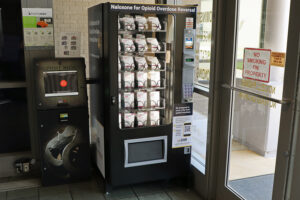
In Arizona and Montana, the Overdose Response Strategy (ORS) is helping strengthen overdose prevention efforts in tribal communities through long-standing partnerships and community-led collaboration. Recent work by the Arizona and Montana ORS teams illustrates how sustained engagement, cultural respect and shared goals are expanding access to naloxone, enhancing data capacity and supporting tribal leadership in addressing the overdose crisis.
In February 2025, the Arizona HIDTA Public Health and Public Safety Initiative, including the Arizona Overdose Response Strategy (ORS) team, traveled to Fort Defiance on the Navajo Nation to deliver a series of six back-to-back community education classes focused on the dangers of fentanyl, how to recognize an overdose and how to administer naloxone. Each class had around 50 attendees, with more than 300 community members participating overall. The event marked the second time the team was invited to present on the Navajo Nation—a testament to the trust and collaboration built with local partners over time.
For the first time, naloxone was distributed directly to members of the Navajo Tribal Housing Authority, with each participant receiving a box of naloxone. In total, 350 boxes of naloxone were distributed during the event, thanks to supplies provided by the Arizona Attorney General’s Office. This effort represents a critical step toward increasing naloxone saturation in communities at higher risk for overdose and empowering residents with the tools to reverse overdoses.
One powerful example of this impact came immediately after the event, a tribal elder shared with the AZ ORS team that she used what she learned to help save her daughter’s life when she experienced an overdose—thanks to her grandson showing her how to administer naloxone.
The Arizona HIDTA Public Health and Public Safety Initiative team worked closely with the local coalition in Apache County, whose representative also co-led instruction. Naloxone was provided by the Arizona Attorney General’s Office and the Arizona Department of Health Services.
Similarly, in Montana, meaningful progress has emerged from years of relationship-building with tribal partners. For nearly three years, the Montana ORS team has prioritized outreach and capacity-building efforts with Montana’s tribal nations. Their commitment and consistency recently culminated in a milestone collaboration with the Blackfeet Nation. Thanks to ongoing visits, check-ins and respectful dialogue, the Blackfeet Nation invited the ORS team to participate in a convening including tribal law enforcement, public health officials, tribal council leaders, EMS and other community partners.
The convening centered on overdose monitoring, addressing data gaps, and identifying response strategies. Through the Blackfeet Nation’s leadership and the MT ORS team’s support, four new agencies signed up for ODMAP during the meeting, marking a significant step forward in data-driven overdose response. This success reflects the Montana ORS team’s patient persistence and exemplifies the ORS program’s core values of respect, responsiveness and community-led solutions.
Both the Arizona and Montana ORS teams demonstrate the power of sustained collaboration, building trust and cultural humility in improving overdose prevention efforts within tribal communities.
 In Arizona and Montana, the Overdose Response Strategy (ORS) is helping strengthen overdose prevention efforts in tribal communities through long-standing partnerships and community-led collaboration. Recent work by the Arizona and Montana ORS teams illustrates how sustained engagement, cultural respect and shared goals are expanding access to naloxone, enhancing data capacity and supporting tribal leadership in addressing the overdose crisis.
In Arizona and Montana, the Overdose Response Strategy (ORS) is helping strengthen overdose prevention efforts in tribal communities through long-standing partnerships and community-led collaboration. Recent work by the Arizona and Montana ORS teams illustrates how sustained engagement, cultural respect and shared goals are expanding access to naloxone, enhancing data capacity and supporting tribal leadership in addressing the overdose crisis.





